Largemouth Bass Lure?
Crankbait, Jig, Plastic Worm Or Spinnerbait. Is there One Best Bass Lure That Is "Specifically" A Largemouth Bass Lure?
There Are So Many largemouth Bass Lures!
Can the question above really be answered when there are thousands, literally thousands of lures to pick from, many of which appear to have no more significant differences between them than do pebbles on a beach?
Well, yes and no. What lure is the best largemouth bass lure or which many anglers might use for only largemouth bass, is in the eye of the beholder.
What types of fishing lures should be presented in any given pattern or habitat situation? Reality is, there is no single "just right" lure.
There are many best bass lures for many different situations.
The best largemouth bass lure is defined not by features of a
singular, specific lure. But by cover, structure, water clarity,
temperature and depth, and the impacts of seasons and weather. How a
lure's design features interact with these influences and best enable it
to draw strikes determines which will be the best lure colors and the
best lure size to be fished. Of course the angler's presentation
technique contributes as well. And the kicker? They're always changing.
So, identifying any one lure as being the best for largemouth bass fishing is very near impossible. Changing conditions and individual lure preference plays to big a part. So choosing a largemouth lure is first a matter of identifying a lure category, such as spinnerbaits, crankbaits, topwater lures, jigs, swimbait lures, soft plastic fishing lures or spoons. Then drilling down to the specific features of a lure within a category that promises the best chance of success when "presented" in the situation/circumstances in which you're fishing.
Who said bass fishing was a no-brainer sport?

The Big Four
|
Crankbait 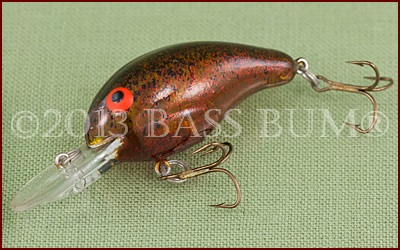 |
Spinnerbait 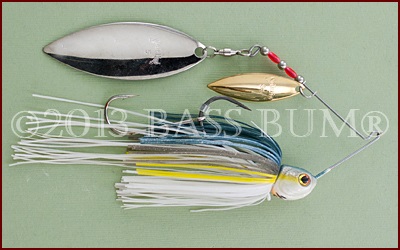 |
|
Jig 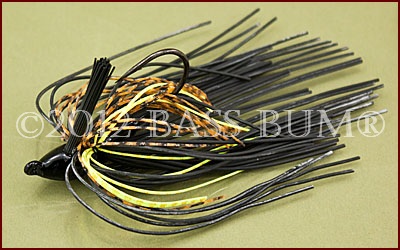 |
Plastic Worm 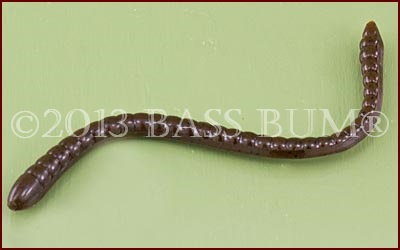 |
A Largemouth Bass Lure For Every Fishing Situation
Every angler has their own opinion about a largemouth bass lure they consider to the best bass lure. Many involve catching bass with lures fished in the unlikeliest of places and under circumstances offering the least prospect of success. An ancient philosopher once said, "Luck never made a man wise". So, if consistent success catching largemouth bass is your goal, you should strive to learn all you can about the features and benefits of largemouth bass lure families and understand how they are best "presented" in specific situations.
In this article lure families that are "dependably", though not "absolutely", productive for catching largemouth are the focus. So here goes, the when, where and how to fish lures that are, at least in my opinion, the gold standards when after largemouth bass. These are where you start. Once on the water you can "fine tune" your choice as to specific features that may best produce.

The Spinnerbait Is A Largemouth Bass Lure With Class
These are such versatile lures that, as such, they rightfully take a place in the top four largemouth bass lures, especially for catching big largemouth bass. Why big largemouth bass? Because spinnerbaits are "quiet" lures, a feature which angler experience and studies show has a particular appeal to bigger, wiser bass. Where bass hang out, quiet prey better fits their world. Spinnerbaits will also catch a ton of largemouth in shallow water.
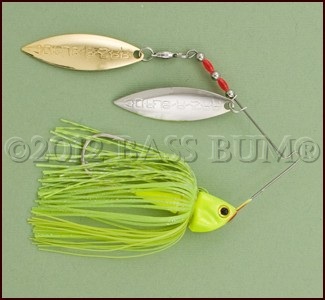
They are also excellent search lures. Because of their safety pin design spinnerbaits have a high resistance to snagging making them very good for fishing grass, brush, around logs and other cover that would devour crankbaits. The very places old bucketmouth likes to hang out.
When to use them?
Use them year round.
Where and How to use them?
Some of the best places are;
- Deep Structure calls for a single, big Colorado blade model retrieved just fast enough to turn the blade.
- Ledges, drops, walls and other vertical structure
- Standing Timber - retrieve slowly being sure to bump/tick limbs.
- Stump Fields and Laydowns are best fished fast by targeting individual stumps with casts beyond the target and retrieves that bump the stump as it passes by.
- Grass
- Flats
Tips
When using a spinnerbait as a largemouth bass lure the following lure fishing tips will help.
- In clear water use smaller size spinnerbaits no heavier than 3/8 ounce. Colors should be natural, translucent to imitate shad or other baitfish.
- If the water is stained or you're fishing 20' deep or more start no smaller than 3/8 ounce and go upward. Brighter colors like chartreuse or even fluorescent colors are more visible to largemouth in stained water.
- In spring smaller spinnerbaits are very capable of hooking big bass. A 1/8 ounce size is a good choice.
- If cold weather bass fishing, upgrade to larger versions of spinnerbaits and slow your retrieve.
- Single Indiana blade models are best when fishing deep as they have less "lift" than do tandem. They also produce more "thump" than do tandem models.
- If bass are active retrieve spinnerbaits rapidly as the speed will trigger strikes from the aggressive largemouth.
- If bass are deep or lethargic retrieve slowly. "Slow-roll" or Yo-Yo the lure. Choose spinnerbaits with Colorado blades.
- Targeting largemouth in grass? Slow roll the lure just over the top or along the grass edge.
- If you feel a pause in blade vibration or sense sudden weightlessness set the hook!

A Plastic Worm Of Any Size Is A High Production Largemouth Bass Lure
Soft plastic lures are so numerous in variety as to make choosing which to use as uncertain as deciding which flavor ice cream to order at Baskin-Robbins. But my experience is that a plastic worm can increase your odds of landing largemouth better than anything else. And do so most any place anytime the water is over 60°. And I mean a worm too. Not grubs, craws, lizards, tubes, flukes or any other of the many soft plastic lures. Now don't misunderstand. I fish all kinds of soft plastic lures, each a bass catcher in its own right. But the gold standard in soft plastics, when talking about a largemouth bass lure, is a worm.
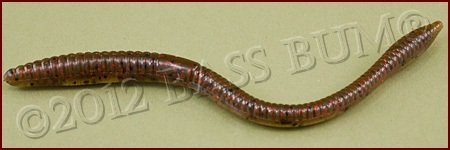
When to use them?
About the only times not ideal for worm fishing largemouth are when they're very active, when faster lures such as spinnerbaits and crankbaits might be better choices and in the dead of winter when they're holding deep.
Where and How to use them?
Worms are certainly not the fastest, most time efficient way to catch largemouth. But plastic worms can certainly catch them in more places. There are numerous rigs for worms and this provides the angler a lot of ways to pursue largemouth in many types of over and structure.
- Deep Structure calls for Carolina rigging a large 8-10" worm or drop shotting a small 3-5" straight tail worm.
- Deep Brushpiles are targets for flipping with 6-7" thick or paddle tail worms. Worms with curly, thin tails tend to wrap around thin branches.
- Vertical structure like rip-rap and bluff walls in clear rocky lakes are great target areas for a Shaky Head worm. Cast parallel and close to the wall. Let it fall to the bottom then shake it, lift it 6-8", give it a shake then drop it again. Do this all the way back to the boat.
- Stump Fields can be effectively covered with a Carolina Rig and texas rigged worm.
- Grass calls for flipping and pitching a Texas rigged straight tail worm with a fairly heavy weight to punch through the mat.
Tips
Plastic worms and largemouth bass go together like pigs and slop. When fishing a worm specifically as a largemouth bass lure the following few tips may help.
- Don't fish them fast!
- As a general rule, plastic worms work best in water over 55°.
- When largemouth are active or the water is stained or murky use bigger worms, 7 to 10". If they are lethargic or spooky in clear water, shorter worms 4-5" are probably a better choice.

- Black, blue and purple color worms have long been productive colors, especially in stained water. Green pumpkin, cotton candy, watermelon red flake and watermelon seed have always worked well for me.
- Retrieve a worm by lifting and dropping then taking up the slack. Don't reel the worm in.
- Try a "floating worm", one that really floats like the Z MAN WormZ. Put a 7" length on a light wire 2/0 or 3/0 hook split-shot rig and hang on. The worm actually floats up off the bottom. Put the split shot about 6" above the worm. Works great with a Carolina Rig too.
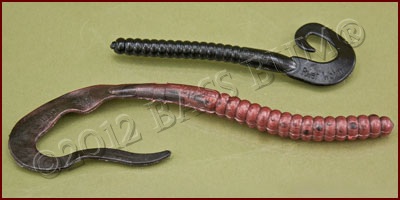
- In clear water choose some type of action tail worm. Remember, they're sight feeders and the subtle action of a thin, action tail often gets their attention.

A Crankbait Is A "Workhorse" Largemouth Bass Lure
Also a very versatile lure like spinnerbaits. Beyond that however, they're great for covering water fast when on the hunt for bass. Remember, at any given time 80% of the water you see holds no bass! So the quicker you find them the better.
A crankbait is a largemouth bass lure that comes in every shape, size, weight and running depth you can imagine. Thus they are a go-to lure for largemouth. However, correct selection is very important. They are a largemouth bass lure that requires angler skill for accurate placement and presentation. With crankbaits, skill correctly presenting them is paramount to success.
They are very effective lures for bass fishing around cover though hanging up is a crankbait fact of life. However, if you shy away from fishing them in cover, for fear of losing some, you will never realize the catching power they have as largemouth bass lure. Surprisingly, many crankbaits are designed to be highly resistant to snagging.
When to use them?
Just about anytime is a good time for fishing crankbaits if targeting largemouth bass. The key is of course, which crankbait.
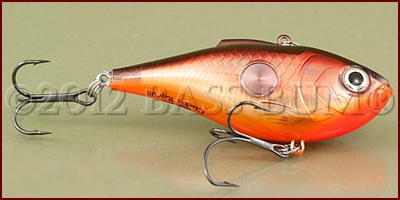
Where and How to use them?
Crankbaits are a good choice for most situations. Just remember, depth and speed are the controlling factors that bring success. With lipped models there are shallow running models designed for 'waking" the surface and down to five feet. Medium depth crankbaits run from five to eight feet with deep divers heading down to the twenty foot mark. The lipless versions like Rat-L-Traps and Redeye Shad can be fished at any point in the water column.
Here are a few places where a crankbait makes a great largemouth bass lure. These work for me. You most likely have others. These are some high probability places where old bucketmouth will be nearby.
- Isolated cover is prime territory for holding largemouth. If you find an isolated tree on a point, along a roadbed or a stump on a flat chances are a largemouth will be hanging tight or close by, depending on the season.
- Grass offers a great opportunity for catching largemouth that are in an active mindset. Focus casting the inside and outside edges. Shallow running crankbaits are what to use for inside edges while deeper diving models are best for outside edges, where the water is deeper and often on the lip of drop.
- Deep Water Humps are bass magnets and often not fished as relentlessly as more shallow structure and cover.
- Ledges and Drops are paths over which largemouth migrate during the change of seasons. Choose crankbaits that will bump the bottom along these structure features.
- Points of rock, gravel, mud or clay should be fan cast with a variety of different crankbaits from both sides, down its spine, shallow to deep and deep to shallow.
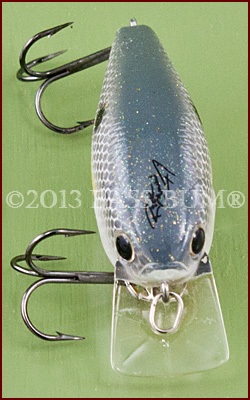
- Shallow Flats are highways and feeding troughs for largemouth. If they have any isolated cover on them cast past and retrieve past it from every direction with a crankbait.
- Stump Fields are transition areas where largemouth can taken with crankbaits bounced off stumps. When they deflect off a stump the resulting erratic motion often serves as a trigger for strikes. Square bill models are a good choice.
Tips
Next time you tie on a "crank" the following few tips on how to fish for bass with crankbaits may prove helpful.
- Never forget, crankbaits are "contact" lures and statistically they trigger the most strikes immediately after deflecting off an object. That includes the bottom of lakes and rivers.
- In warm water, above 60, choose crankbaits that have a pronounced wobble. In cold water the, below 60,crankbaits that have a tighter wiggle are better.
- If the water is stained so a white object is visible at 2-4', choose a "wobble" crankbait.
- Lipless crankbaits are my crankbait of choice for fishing in grass with a "ripping" retrieve.
- Take notice of the lure's "manufacturer published" running depth. For the most part they are sadly not correct. Look at the bill length and angle. The shorter the bill and more acute the angle the more shallow the dive. The longer the bill and the slighter the downward angle the greater the depth.
- Clear water calls for natural color and speed. Fish "sight feed" in clear water and you don't want them to get to good a look at the lure. They may have a tiny brain but they aren't stupid.
- Fish larger crankbaits for largemouth, 3-5" in length.
- Crankbaits that rattle are a good choice when the water is moderately or heavily stained. Silent lures, I've found, are a better choice in clear water.
- Buy a crankbait retriever! It will pay for itself in short order. The ROI on these little devices would make a stock brokers head swim.Of course, you can make your own with a little imagination.

The Jig Is A Largemouth Bass Lure "World Cage Fighter"
A jig is recognized not only as a largemouth bass lure but also as a big bass lure that is fished most often by flipping and pitching rather than casting. Developing skill at catching bass with these lures is a challenge. They have a habit of hanging up because they're best fished close to or in contact with cover. In most situations they are best fished slowly.
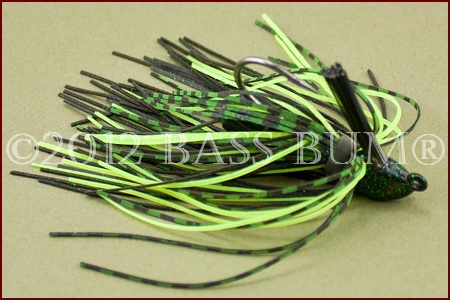
When to use them?
Jigs are a largemouth bass lure that can be fished year round though spring and summer are the best seasons for them. However, they can also be good producers in cold water when fished slow.
Where and How to use them?
A jigs is largemouth bass lure that can be fished year round.
- Laydown trees are often hiding bass. Pick out the angles where limbs connect to trunk and flip or pitch a jig to them, allowing it to fall slowly on semi-tight line all the way to the bottom.
- Brushpiles on a rocky bottom are high percentage areas for catching largemouth on jigs, in both warm and cold water. Such cover and structure attracts crawfish and baitfish as well as providing cover for largemouth.
- Ledges and Drops are structure features that are frequented by largemouth in every season. They will either hold on these features or move along them in transition periods between spring/fall and winter/spring. Slowly drag or hop jigs down the ledges from shallow to deep water.
- Standing Timber is best fished by dropping the jig next to the trunk and allowing it to drop slowly down the trunk on a semi-tight line.
- Stump Fields are potential producers of big numbers of largemouth. I fish them with fast baits and if I find some bass try to target fish them with jigs.
- Grass like hydrilla and milfoil are often very thick and nothing works better for rooting out the big bucketmouth hawgs than a jig, One of 3/4 ounce or more.
- Flats are not in my opinion the best areas for fishing jigs except maybe a swim jig. Then it's best to cast past any isolated cover found on the flat and swim it close to it, even bump it, as you retrieve the jig.
- Docks and piers are prime jig fishing spots. They provide protection from overhead predators
Tips
A jig is first and foremost a largemouth bass lure. The following are some helpful tips.
- After casting your jig maintain constant contact with it via a semi tight line. Even a brief lapse in concentration can result in a lost bass, as most strikes occur on the fall and they can suck a jig in and spit it out faster than you can blink.
- Jigs most closely imitate crawfish so keep that in mind when fishing them. Keep them in contact with the bottom as you retrieve it, like a crawfish scoots along the bottom. If your using a football head jig absolutely keep it dragging across the bottom.
- Watch your line and if you see the slightest twitch reel down till you feel "life" on the line then set the hook. Bass don't usually slam jigs like they do crankbaits or run with the lure like they do plastic worms. Often they merely suck it in very lightly and either spit it out quickly or "gum it" like grandpa eating a banana. If you reel down and there is a bass on the line the sensation will be weightlessness or a feel you will instinctively realize is not a rock, stump or tree trunk. Don't engage in a gentle tug of war with it, you'll lose. You feel him/her, set the hook.
- Jig colors should be light on bright days and dark for cloudy, overcast days. Clear water calls for lighter colors while in stained to muddy water dark colors, even black, show up well. Jig color is a subject on which an entire other page can be written.
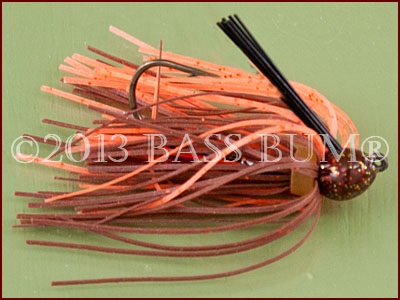
- A 3/8 ounce jig is by far the most popular all around size but smaller jigs, like the Strike King Bitsy Bug, which is equipped with a heavier than normal hook usually found on smaller jigs, are very effective in clear water.
Back To Largemouth Bass Fishing From Largemouth Bass Lure
